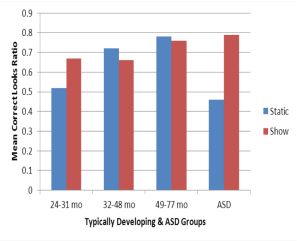Autism Research with Mangold Vision Eye Tracking
How Autism Spectrum Disorder (ASD) children can be supported in word-learning. An eye tracking study made with the Mangold Vision Eye Tracking system.
Hypothesis
Based on the results of previous studies, researchers suggest that dynamic gestures when learning words, will aid ASD children more than typically developing children (TD).

Methods
The test children, both the TD children aged 2-6 years and the ASD children aged 5-8 years, watched a video showing a speaker introducing two new objects. When naming the objects, he held them either statically or used synchronous gestures. A Mangold Eye Tacking Systemwas used to collect the eye gaze data of the test children. Afterwards, the ASD children were compared with the TD children, within the different age groups.

Results
The results show that the benefit of corresponding gestures is most significant for the ASD children (69-98 months). Among the TD children only the youngest age group (24-31 months) benefits from the additional stimuli, whereas it makes no difference in the two older age groups (32-48 months and 49-77 months).
In combination with a dynamic show gesture, the ASD children’s word learning was as good as that of the oldest TD children, while it was similar to the youngest age group for the static gesture condition.
Discussion
The study concludes that dynamic show gestures offer a significant benefit and assist word learning in ASD children. This is due to the fact that the motion, in the show gesture procedure, produces stimulus-driven attention that assists the ASD children in attending at the critical time, when they view the object and hear its word. The visualization assists the attention.
The study was conducted in the Ithaca College Cognition Lab and presented at SRCD in Seattle.

